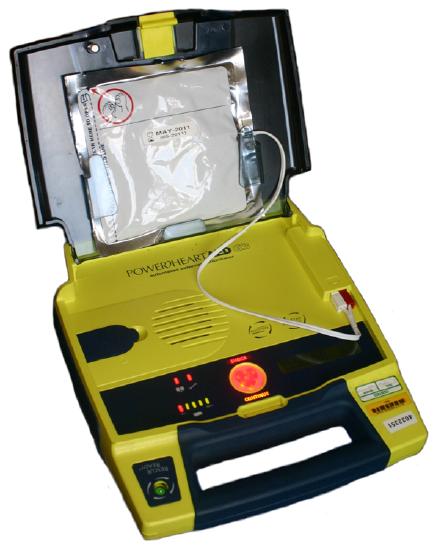19.7: Energy Stored in Capacitors
( \newcommand{\kernel}{\mathrm{null}\,}\)
Learning Objectives
By the end of this section, you will be able to:
- List some uses of capacitors.
- Express in equation form the energy stored in a capacitor.
- Explain the function of a defibrillator.
Most of us have seen dramatizations in which medical personnel use a defibrillator to pass an electric current through a patient’s heart to get it to beat normally. (Review Figure 19.7.1.) Often realistic in detail, the person applying the shock directs another person to “make it 400 joules this time.” The energy delivered by the defibrillator is stored in a capacitor and can be adjusted to fit the situation. SI units of joules are often employed. Less dramatic is the use of capacitors in microelectronics, such as certain handheld calculators, to supply energy when batteries are charged. (See Figure 19.7.1.) Capacitors are also used to supply energy for flash lamps on cameras.

Energy stored in a capacitor is electrical potential energy, and it is thus related to the charge Q and voltage V on the capacitor. We must be careful when applying the equation for electrical potential energy ΔPE=qΔV to a capacitor. Remember that ΔPE is the potential energy of a charge q going through a voltage ΔV. But the capacitor starts with zero voltage and gradually comes up to its full voltage as it is charged. The first charge placed on a capacitor experiences a change in voltage ΔV=0, since the capacitor has zero voltage when uncharged. The final charge placed on a capacitor experiences ΔV=V, since the capacitor now has its full voltage V on it. The average voltage on the capacitor during the charging process is V/2, and so the average voltage experienced by the full charge q is V/2. Thus the energy stored in a capacitor, Ecap, is
Ecap=QV2,
where Q is the charge on a capacitor with a voltage V applied. (Note that the energy is not QV, but QV/2.) Charge and voltage are related to the capacitance C of a capacitor by Q=CV, and so the expression for Ecap can be algebraically manipulated into three equivalent expressions:
Ecap=QV2=CV22=Q22C,
where Q is the charge and V the voltage on a capacitor C. The energy is in joules for a charge in coulombs, voltage in volts, and capacitance in farads.
ENERGY STORED IN CAPACITORS
The energy stored in a capacitor can be expressed in three ways:
Ecap=QV2=CV22=Q22C,
where Q is the charge, V is the voltage, and C is the capacitance of the capacitor. The energy is in joules for a charge in coulombs, voltage in volts, and capacitance in farads.
In a defibrillator, the delivery of a large charge in a short burst to a set of paddles across a person’s chest can be a lifesaver. The person’s heart attack might have arisen from the onset of fast, irregular beating of the heart—cardiac or ventricular fibrillation. The application of a large shock of electrical energy can terminate the arrhythmia and allow the body’s pacemaker to resume normal patterns. Today it is common for ambulances to carry a defibrillator, which also uses an electrocardiogram to analyze the patient’s heartbeat pattern. Automated external defibrillators (AED) are found in many public places (Figure 19.7.2). These are designed to be used by lay persons. The device automatically diagnoses the patient’s heart condition and then applies the shock with appropriate energy and waveform. CPR is recommended in many cases before use of an AED.

Example 19.7.1: Capacitance in a Heart Defibrillator
A heart defibrillator delivers 4.00×102J of energy by discharging a capacitor initially at 1.00×104V. What is its capacitance?
Strategy
We are given Ecap and V, and we are asked to find the capacitance C. Of the three expressions in the equation for Ecap, the most convenient relationship is
Ecap=CV22.
Solution
Solving this expression for C and entering the given values yields
C=2EcapV2=2(4.00×102J)(1.00×104V)2=8.00×10−6F
=8.00μF.
Discussion
This is a fairly large, but manageable, capacitance at 1.00×104V.
Summary
- Capacitors are used in a variety of devices, including defibrillators, microelectronics such as calculators, and flash lamps, to supply energy.
- The energy stored in a capacitor can be expressed in three ways: Ecap=QV2=CV22=Q22C, where Q is the charge, V is the voltage, and C is the capacitance of the capacitor. The energy is in joules when the charge is in coulombs, voltage is in volts, and capacitance is in farads.
Glossary
- defibrillator
- a machine used to provide an electrical shock to a heart attack victim's heart in order to restore the heart's normal rhythmic pattern


